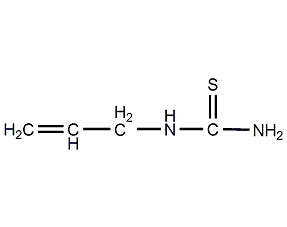Allylthiourea Allylthiourea


Structural formula
| Business number | 02Z7 |
|---|---|
| Molecular formula | C4H8N2S |
| Molecular weight | 116.18 |
| label |
propylene thiourea, thioglucosamine, Allylthiourea, 1-allyl-2-thiourea, N-allylthiourea, propylene urea, Sulforaphane oil, Alithiourea, Propenylthiourea, N-Allylthiourea, N-(2-Propenyl)thiourea, Thiosinamine, Rhodalline, Labotest-bb lt00025093, 1-Allyl-2-thiourea, Aminosin, additive, preservative |
Numbering system
CAS number:109-57-9
MDL number:MFCD00004940
EINECS number:203-683-5
RTECS number:YR8050000
BRN number:1071470
PubChem number:24845795
Physical property data
1. Properties: white crystal. Slightly smell of garlic.
2. Density (g/mL, 25/4℃): 1.22
3. Relative vapor density (g/mL, air=1): Undetermined
4. Melting point (ºC): 76-78.05
5. Boiling point (ºC, normal pressure): Undetermined
6. Boiling point (ºC, 5.2kPa): Undetermined Determined
7. Refractive index: Undetermined
8. Flash point (ºC): Undetermined
9. Specific rotation (º): Undetermined
10. Autoignition point or ignition temperature (ºC): Undetermined
11. Vapor pressure (kPa, 25ºC): Undetermined
12. Saturation Vapor pressure (kPa, 60ºC): Undetermined
13. Heat of combustion (KJ/mol): Undetermined
14. Critical temperature (ºC): Undetermined
15. Critical pressure (KPa): Undetermined
16. Log value of oil-water (octanol/water) partition coefficient: Undetermined
17. Explosion upper limit (% , V/V): Undetermined
18. Lower explosion limit (%, V/V): Undetermined
19. Solubility: Soluble in water and ethanol, slightly soluble in Ether, insoluble in benzene.
Toxicological data
1. Acute toxicity: rat oral LD50: 200mg/kg; rat intraperitoneal LD50: 500mg/kg; rat subcutaneous LDLo: 50mg/kg; mouse intraperitoneal LC50: 1858mg/kg; dog Intravenous LDLo: 110mg/kg;
2. Mutagenicity
Mutation of microbial Salmonella typhimurium: 150μg/plate;
Ecological data
1. Other toxic effects: This substance is slightly harmful to water.
Molecular structure data
5. Molecular property data:
1. Molar refractive index: 34.72
2. Molar volume (cm3/mol): 107.1
3. Isotonic specific volume (90.2K): 283.8
4. Surface tension (dyne/cm): 49.2
5. Dielectric constant:
6. Dipole moment (10-24cm3):
7. Polarizability: 13.76
Compute chemical data
1. Reference value for hydrophobic parameter calculation (XlogP): 0.2
2. Number of hydrogen bond donors: 2
3. Number of hydrogen bond acceptors: 1
4. Number of rotatable chemical bonds: 2
5. Number of tautomers: 3
6. Topological molecule polar surface area 70.1
7. Number of heavy atoms: 7
8. Surface charge: 0
9. Complexity: 79.8
10. Number of isotope atoms: 0
11. Determine the number of atomic stereocenters: 0
12. Uncertain number of atomic stereocenters: 0
13. Determine the number of chemical bond stereocenters: 0
14. Number of uncertain chemical bond stereocenters: 0
15. Number of covalent bond units: 1
Properties and stability
1. Avoid contact with chlorine, a strong oxidizing agent.
2.Burning produces toxic nitrogen oxide and sulfur oxide smoke.
3. Toxic when taken orally. It is irritating to the eyes, respiratory system and skin. Wear appropriate protective clothing when using in large quantities.
Storage method
1. Store in a cool, ventilated warehouse. Keep away from fire and heat sources. Keep container tightly sealed.
2. They should be stored separately from oxidants and avoid mixed storage. Use explosion-proof lighting and ventilation facilities. It is prohibited to use mechanical equipment and tools that are prone to sparks. The storage area should be equipped with emergency release equipment and suitable containment materials.
Synthesis method
1. From the reaction of allyl chloride and sodium thiocyanide, first heat and dissolve the sodium thiocyanide, add a small amount of potassium iodide after cooling, then add allyl chloride and ethanol, reflux for 16 hours, cool and separate the oil layer and wash it with water 3-4 times Allyl isothiocyanate is obtained, dried with anhydrous calcium chloride, distilled, and the fraction with a boiling point of 140-155°C is collected to obtain “ester”. Then add it to ammonia water and heat to about 80°C with stirring, a violent reaction occurs, cool to precipitate crystals, filter, and dry to obtain crude product, which is then recrystallized from ethanol to obtain the finished product.
Purpose
1. Determination of cadmium and uranium. Corrosion inhibitors. Organic Synthesis.
2.This product can be used as a cyanide-free copper plating additive to increase the brightness and corrosion resistance of the plated product. It can also be used as a preservative.